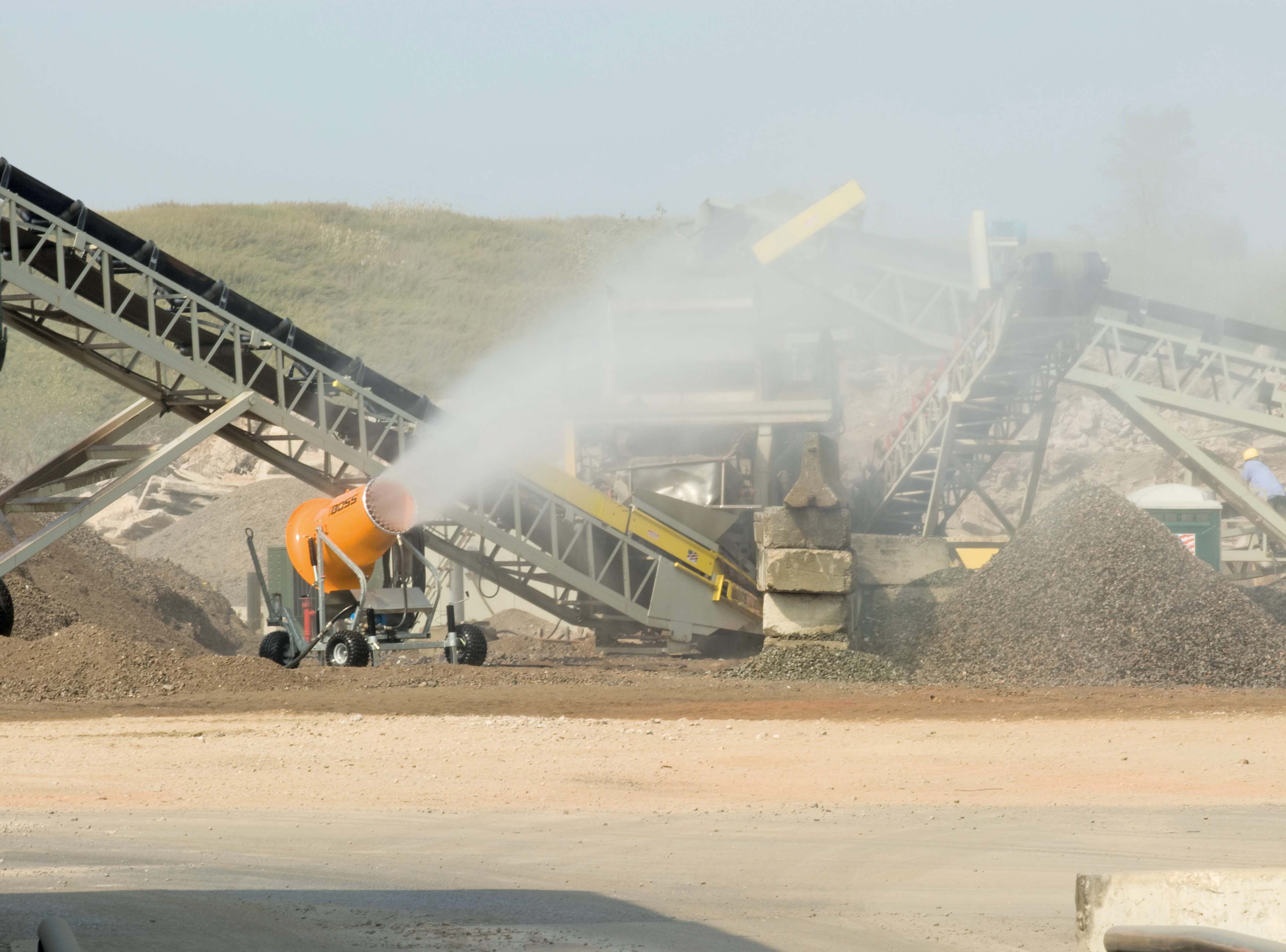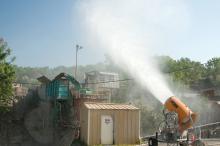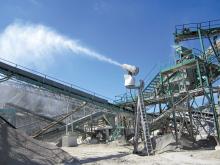
Quality dust monitoring solutions are vital to retaining the best occupational health among staff in every quarry, as Guy Woodford reports.
UK-based dust monitoring solution firm
“In the quarrying industry, long-term exposure to fine dust created during heavy industrial processes such as drilling and blasting poses a severe risk to the health of workers,” a company spokesperson states.
While industrial accidents grab the headlines, the Casella spokesperson says occupational illnesses are far bigger killers. The firm cites the UK’s Trades Union Congress (TUC) estimates that diseases caused by occu-pational health exposure, such as breathing in fine dust, kill six times more employees than work-related accidents.
For this reason, Casella notes, the TUC wants industry to give occupational health the same priority as injury preven-tion measures, effectively treating health in the same way it treats safety.
The Casella spokesperson continues: “This is a particular problem in industries like coal mining and aggregates, where workers are exposed to dust and fumes on a daily basis. The effect of dust inhalation has a long latency period. It may take many years for diseases, from respiratory conditions like emphysema and asthma, to cancers of the lungs, throat and nose, to develop.
“It is estimated that there are about 2 million deaths annually caused by work-related disease, while the annual global number of cases of non-fatal, work-related disease is estimated to be 160 million. International Labour Organisation (ILO) figures estimate the direct and indirect cost at US$2.8 trillion, which equates to around 4% of global GDP.”
In order to measure levels of dust, a site survey may be carried out. The survey checks background levels of dust and highlights problem areas or problem operations. An instrument such as a Casella Microdust Pro, which is a rugged, handheld data-logger giving a real-time, graphical display of airborne dusts, could be one solution.
However, Casella says the only way to keep a handle on workers’ exposure is through accurate personal monitoring. In challenging environments such as quarrying, this would include the use of personal air sampling pumps to monitor the level of harmful dusts that workers are actually breathing in.
The Casella spokesperson continues: “Dust particles are categorised according to size and for personal monitoring there are generally two frac-tions of interest: ‘Total Inhalable Dust’ and ‘Respirable Dust’. ‘Total Inhalable Dust’ is the total amount of airborne material that enters the respiratory system. These particles can be up to 100 microns in size, but the larger particles in this fraction are generally caught in the respira-tory tract and expelled by the body’s own defences. However, the smaller particles – up to about 10 microns in size – are termed ‘Respirable Dust’. It is this fraction that causes the most harm as these particles are the ones that penetrate into the deep lung where gas exchange takes place and get lodged there.
“The globally accepted way to monitor personal dust expo-sure involves a known volume of air being drawn through a preweighed glass fibre (GFA) filter using a sampling pump. Different sampling heads can be selected to determine either ‘Total Inhalable’ or ‘Respirable’ fractions. After sampling, the filter is reweighed and the differ-ence in weights along with the time worked is used to calculate the worker’s exposure.”
Casella developed its first sampling pump for use in coal mines 60 years ago. The new generation of intrinsically safe (IS) TUFF pumps are said by the firm have come a long way since then and have all the certifica-tions to meet The Coal Mines (Control of Inhalable Dust) Regulations 2007, with improved flow control for use in deep mines. The TUFF pump is also widely used in the quarries and aggregates industry.
The TUFF pump is said to offer a robust and reliable design for harsh environments. It has an intuitive user interface and menu with high intensity status and alarm LEDs. It has intelligent battery management allowing charging in single or 3-way formats. Full charge can be obtained in typically less than five hours or the trickle charge control maintains optimum battery condition.
Sampling for personal exposure is paramount for the continued health of workers, but Casella says there is still a need to monitor levels of environmental dust to gauge the impact of the industrial process on the neighbouring surroundings.
Equipment such as a Boundary Guardian is, says Casella, ideal for this type of monitoring: a multi-parameter monitor for noise and dust and providing wind speed and direction data. A company spokesperson explains why. “This remote site monitoring equipment logs data continuously and can transmit local alarms and send emails to site managers if preset dust or noise limits are exceeded. It is available with any combination of noise, dust and meteorological parameters to meet the needs of each particular site. Data is transferred via GPRS to a dedicated, secure website, where it can be viewed in any browser via private log-in to show both real-time and historical data.”
The Boundary Guardian (BG) uses what Casella describe as proven measurement technologies, featuring real-time dust and noise levels, as well as an IEC61672-1 compliant sound level meter. It has a heated inlet to remove moisture resulting in accurate dust measurement and a solid state wind speed and direction sensor to minimise maintenance.
The BG can be positioned at various strategic points around the site where excess dust might be an issue or where there may be an impact on neighbouring businesses or homes.
The Casella spokesperson adds: “This combined approach to monitoring; keeping tabs on both environmental and personal exposure levels, will help to give a clear picture of the levels of dust in the industrial process and highlight the potential impact in order to put proper control measures in place.”
Italy-based
Compact, easy to handle, with the possibility of changing the geometry of the covered area by the fine water spray, the L3 lance is said to work well in small spaces outdoors and indoors, in quarries, demolition works, recycling centres, tunnelling works and in industrial storage areas, where it can be placed directly at the dust’s source. The L3 lance is controlled by a remote control
with which you manage the rotation and inclination of its head and the remaining functions. The reduced water and energy consumption when using the L3 lance make it a very environmentally-friendly solution.
The Hp System from EmiControls is said to be very flexible, tailored to the customers’ needs, and easy to install and use. Different pumps are able to work with water flow from 1 l/min to 21 l/min and with a working pressure from 5-150bar. The nozzles’ size is adapted to any requirement. The lines can be pressure hoses or stainless-steel pipes, and the pumps’ covering panels are made of aluminium. This means the pump is protected from dirt and hits.
Thanks to filter stations (manual or automatic) maintenance of pumps and nozzles can be planned regularly and grant long working periods. When required, pumps can also be equipped with a remote control unit.
In North America,
“UL certification affirms the safety of these three fan-driven designs,” said Laura Stiverson, General Manager of Dust Control Technology (DCT), manufacturer of the DustBoss range. “Their effectiveness has been proven through more than a decade of use in severe operating conditions, such as demolition, mining and coal handling. From the time of their introduction, product safety has always been a priority, but now customers have the added assurance of certifica-tion by an independent source.”
Using standards developed by UL and CSA, the evaluation and certification process was conducted by SGS, a globally respected Nationally Recognised Testing Laboratory (NRTL) accredited by OSHA (Occupational Safety and Health Administration). The organisation is an ISO Guide 65 Certification Body accredited by International Accounting Standards (IAS) to list products
in the US. The NRTL program was created by OSHA in 1995 to standardise testing across multiple providers and has become the measure of safety testing for equipment manufactured around the world.
The certification process required DCT to submit equipment for rigorous testing under a specific set of criteria.
The DustBoss series of oscillating atomising sprayers is designed for safe and effective open-area dust and odour suppression, with a variety of safety features such as fans with heavy-duty guarding, atomiser rings with pressure output that’s safe enough for bare fingers and industrial strength, steel-framed wheeled carriages or skid mounts. The high-powered fans distribute the atomised mist at noise levels below OSHA approved decibel thresholds and low water usage allows safer control of runoff.







